Quick Kanban Tutorial: Insight into the Concept
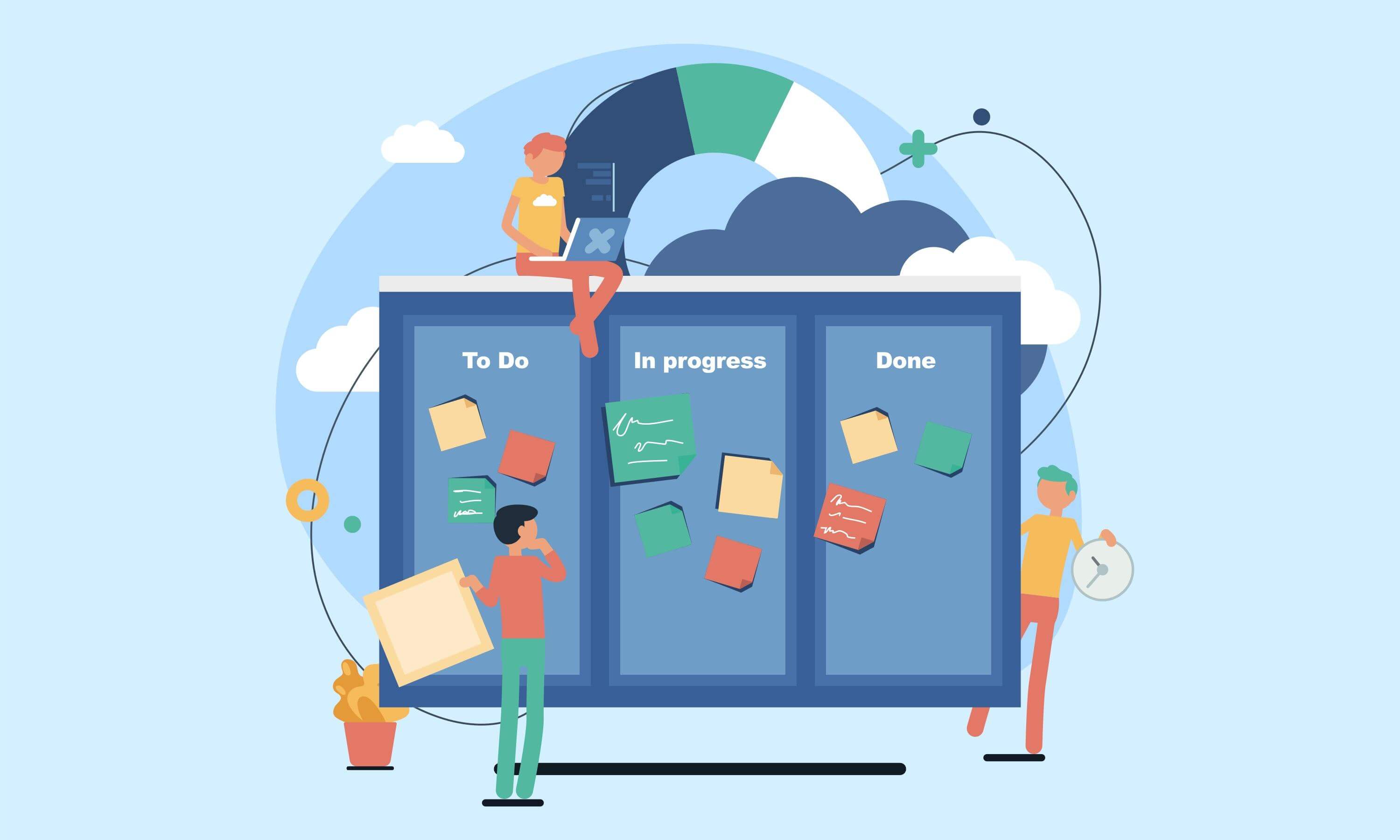
You will probably experience some difficulties trying to find a person in modern business and management environment who has never heard about Kanban.
In fact, there are many people with a very superficial understanding of what this methodology is, but the general idea of Kanban is quite simple and accessible to all.
In this article, you’ll learn about:
3. Kanban in Project Management
Kanban has earned its popularity and today the method is considered to be one of the main project management trends and development artifacts.
This post is a quick Kanban guide that will assist you in understanding the real benefits of the method and the areas of its implementation. As a bonus, at the end of the tutorial, you’ll find some useful links that may empower your overview of the subject.
1. Brief Kanban Intro
1.1. What is Kanban?
This Japanese word literally means a “visual card”. The term “Kanban” was created to indicate a workflow that limits Work In Progress (WIP). The concept has been used in Lean Production for over half-century.
Actually, Kanban is a direct implementation of a Lean Pull Scheduling System. A task can be moved to the next state only when it obtains a slot in there.
The main Kanban concept is about:
- Visualizing workflow – you split the work into the segments or states, visualized as named columns on a wall. Then you should write every item on a Kanban card and put in a column to indicate where the item is in the workflow.
- Limiting WIP – you assign the limits to how many items can be in progress at each workflow segment or state. i.e.
- Measuring the Lead Time – this is the average time to complete a single item. You measure the Lead Time and optimize the process to make the Lead Time as small and predictable as possible.
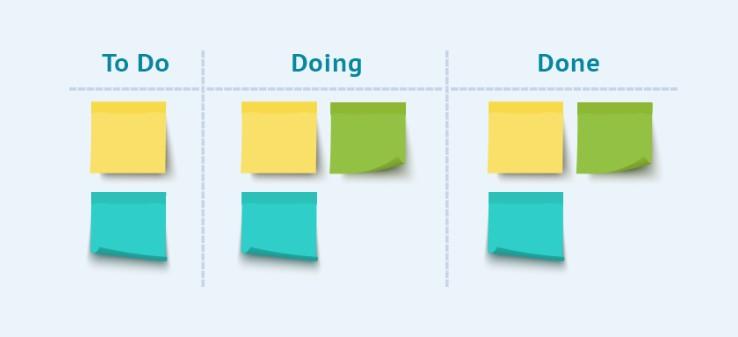
1.2. Kanban roots
The story of Kanban began in the early 1940s. An industrial engineer, Taiichi Ohno developed the first Kanban system for Toyota automotive in Japan.
Toyota company originally used Kanban cards to limit the amount of inventory tied up in “work in progress” in the manufacturing area. The approach helped to reduce excess inventory waste and the time spent in producing it.
The main goal of the simple planning system was to control and manage work and inventory at each production stage.
Toyota company was not so productive and efficient as its American competitors, and that was the main reason for creating and development of Kanban. Thanks to the Kanban approach, Toyota got an effective and flexible production control system that increased productivity inside the company and reduced inventory of raw materials and finished products.
People immediately realized that Kanban is an ideal system to control the entire value chain from the supplier to the end consumer.
It helped to avoid supply disruption and goods overstocking. Over time, the method with boards and cards has become an efficient way in a variety of production systems.
1.3. Kanban-Lean practices
Kanban (as other Lean Manufacturing Methods) may significantly benefit almost any type of work. The method is more effective, as it visually indicates when the production should start and stop.
It looks more efficient, faster, and saves money over most other production models.
1.4. What are the benefits of Kanban?
- Kanban visualization allows defining bottlenecks quickly in real-time. It motivates team members to collaborate in order to optimize the whole value chain rather than just their part.
- Kanban is really good for cases where operations and support teams have a high rate of variability and uncertainty.
- The concept looks appropriate for spreading throughout the company naturally (including sales and management).
- All the required items continually support all the tasks in the workflow since all workflow segments are visually organized.
- Kanban reduces inventory, decreasing the company’s costs.
- Kanban excludes overproduction of inventory. It saves resources and time and is termed as eliminating waste.

2.Kanban Principles
Kanban does not force changes from the outset, like other workflow management methods. It is reaching popularity as the approach of smoothly implementing Agile and Lean management in tech and non-technical companies all over the world.
There are many ways to define Kanban, however, the key its principles stay infrangible:
2.1. Flexible planning system
Kanban improves the workflow. The speed of moving from one task to another is reduced thanks to workflow visual representation.
If a task needs a longer duration, you may execute it without hindrance, and at the same time, the tasks that are completed will flow to the next state.
What does it allow?
- The longer tasks which can not be broken down logically have sufficient duration
- These longer tasks preserve their value.
- Efforts required by each role to be expended.
- There is the continuous flow of the tasks that are completed without wait time.
All this means that planning is flexible and not time-boxed.
2.2. WIP (Work in progress) limits
Limiting how much unfinished work is in the process, you reduce the time it takes an item to move through the Kanban board. It also helps to avoid challenges caused by task switching and reduces the need for permanent reprioritize items.
The feature that is named as WIP limits option enables teams to deliver quality work faster than ever in a more sustainable and healthy environment.
According to Kanban, we assign limits to the number of items that can be in progress at each workflow state.
What does it allow?
- We reduce the wait time
- Avoid stress on resources
- Identify bottlenecks and resolve them with the entire team.
- Decrease dependencies in completing a task by splitting it into sub-tasks
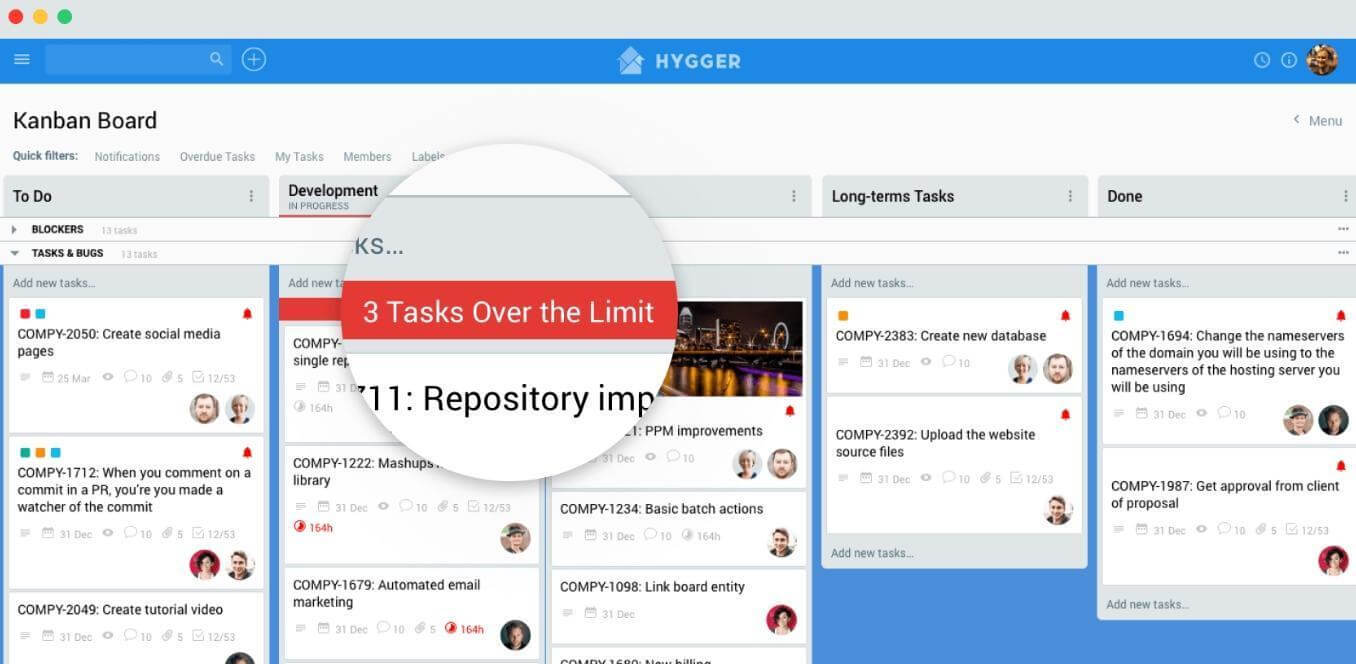
2.3. Swimlanes and the attention to the most important
Switching to Kanban software development leads to doing only the things that added value to the product.
Swimlanes (horizontal columns on a Kanban board) is designed to help you separate important things from not important ones. Typically, developers use the following Swimlanes:
- Blockers – for tasks and bugs that need to be fixed in real time.
- Tasks and Bugs – common challenges.
- Someday – tasks/bugs that became irrelevant or have never been relevant.
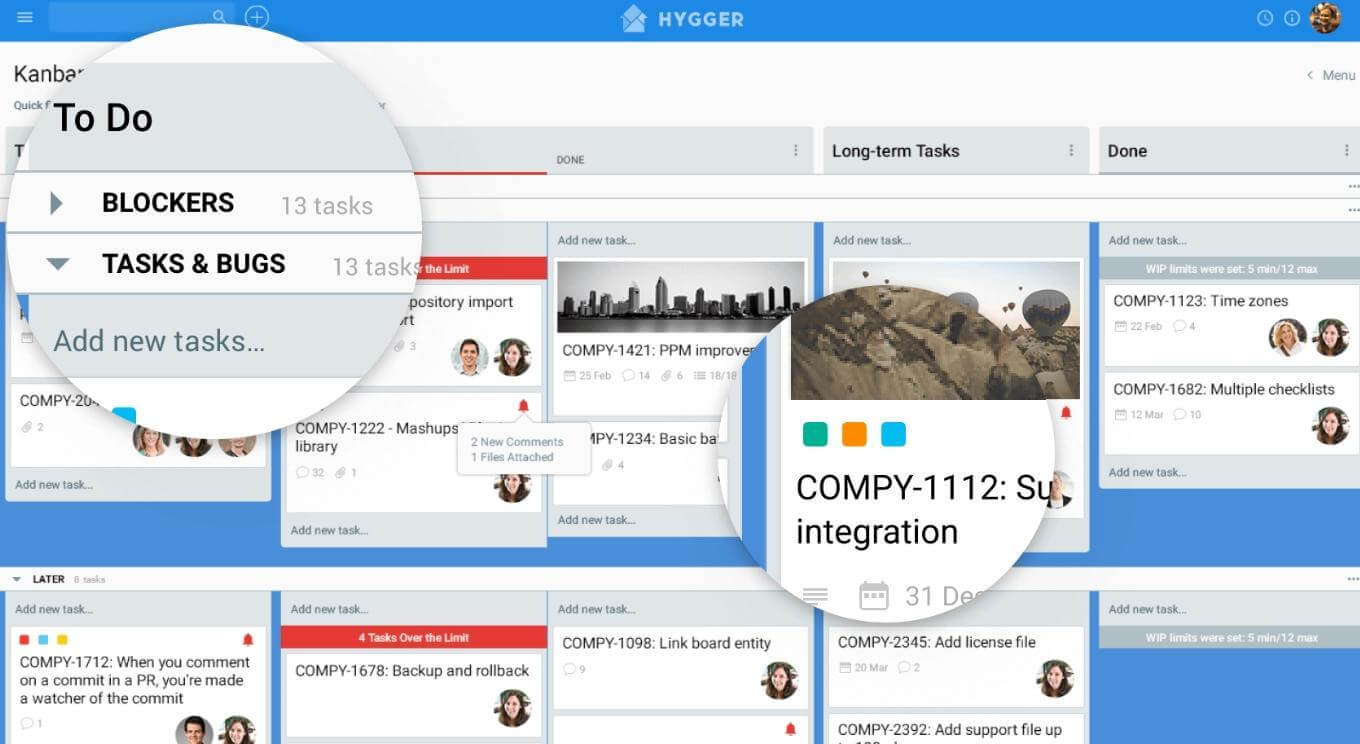
2.4. Pull Approach
Pull Approach means the situation when the next team pulls work only when it is ready for it. Meaning, that you have two teams and the first team is performing better than the second one. This may create friction between them. Pull Approach is the solution.
What are the benefits?
- Pull Approach helps to avoid piling-up of work.
- It reduces wait time.
- It facilitates a team to focus on quality and maintain a constant pace
- It provides resource balancing
2.5. Minimizing Cycle Time
You measure the cycle time for each task and the process is optimized to reduce the cycle times. It means that you can identify bottlenecks immediately and resolve them with your team.
2.6.Continuous Delivery
Continuous delivery is beneficial because of:
- Continuous interaction with a customer.
- Short release cycles lead to continuous delivery of the growing product at regular intervals.
- Better understanding of what customers want.
- You do not produce anything that your customer does not need.
- Limited requirements in every release cycle.
- There is no overloading with requests. This enables developers to focus on the delivery.
- No partially completed work.
- More focusing on finishing work than on starting work.
- Focusing on the quality of the product and sustaining pace
- Assistance in incremental process improvements.
- Delivering before the customer changes mind.
2.7. Visual metrics
Organized workflows in Kanban facilitate scheduling as per WIP limits on a workflow state, tracking status and progress and assigning resources based on the role requirements.
The metrics are tracked visually in Kanban with the help of Kanban boards and a Burndown Chart.
We use a Kanban board is used to:
- Measure the cycle times
- Track WIP limit to eliminate waste
- Monitor resource utilization to eliminate waste
We use a Burndown chart to capture:
- The current tasks/stories’ status
- The rate of progress in completing the remaining tasks
2.8. Efficiency through focus
Focusing on your customers’ needs, you get a clear scope. The focus is on delivering value to the customer.
3. Kanban in Project Management
Kanban is also widely used as a project management approach that adapted to software development. It supports a continuous workflow known as Value Stream.
3.1. Value Stream
Value Stream involves all actions required to bring a project from its creation to completion. These actions may add value to the project, add no value, but unavoidable, add no value, avoidable (termed as waste).
3.2. Elimination of waste
Waste is everything that does not add any value to the project. There are three types of waste in software development: waste in code development, waste in project management, waste in team potential.
3.3. Waste in code development
This kind of waste is due to such reasons as:
- Partially completed work. It can become unusable and outdated. This waste can be eliminated with iterative cycles and modular code (that completes within the iteration).
- Defects. Corrections and retesting require time and resources. This may be eliminated with a relevant test suite, completing testing within the iteration as well as customer feedback.
3.4. Project management waste
The reasons that determine the waste in project management are the following:
- Extra processes. It’s about unnecessary documentation that requires time and resources. It can be solved with the help of pre-planning of what processes are relevant and necessary or with documentation review.
- Code handoffs. It’s about passing the work from one person to another after the first person’s work is complete. The lack of knowledge may occur.
- Extra features. These features are not required by the customer. Effort and time are wasted. Continuous interaction with customer and testers will help to eliminate it.
3.5. Waste in team potential
This kind of waste is due to such reasons as:
- Task Switching that leads to the danger of multitasking. You can eliminate this waste by focusing on a task with every release. Large process stages are divided into tasks to improve visibility, reduce dependencies, enable the easy flow of work, focus on the cycle-time of delivered work and give a way to detect and resolve bottlenecks.
- Waiting (time for getting instructions or information). Your team can sit idle if the decisions are not made by the team or if the info provided are expensive resources. Solve this by allowing the team members to take decisions (so that they do not have to wait for instructions) and to have access to information (so that it can be used as and when required).
4. Agile Kanban
According to Agile, if values are combined with Kanban concepts, then the outcome would be Agile Kanban.
Nowadays the great combination of the Agile iteration approach and Kanban value stream is gaining popularity in software development.
Agile Kanban is software development concept with the Kanban approach. It means that Kanban boards are used to visualize the workflow.
These boards can be simply put up on a wall. The status and progress of the tasks are tracked visually with the help of flowing Kanban cards.
4.1. What is a Kanban board?
A typical Kanban board is used to reflect the flow of tasks across the value stream. This board gives easy access to everyone involved in the project, improve communication, visually displays the progress of the tasks and makes bottlenecks visible as soon as they occur.
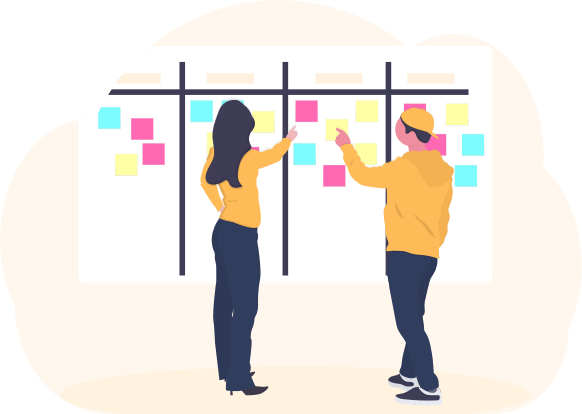
4.2. Kanban boards benefits
- Empowers teams:
Teams can make their decisions when required and collaboratively resolve the bottlenecks. They have access to relevant information and can continually communicate with customers.
- Continuous delivery:
With the help of the simple Kanban board example, you focus on work completion. The boards provide focus on delivering value to the customer and emphasis on the whole project.
In Agile Kanban, tasks and stories are visualized with the help of special cards.
Each card reflects the current status of every task in separate columns on the board. These columns are typically labeled as To Do, In Progress (Doing), and Done. Kanban boards are updated on a daily basis as the team progresses through the development.
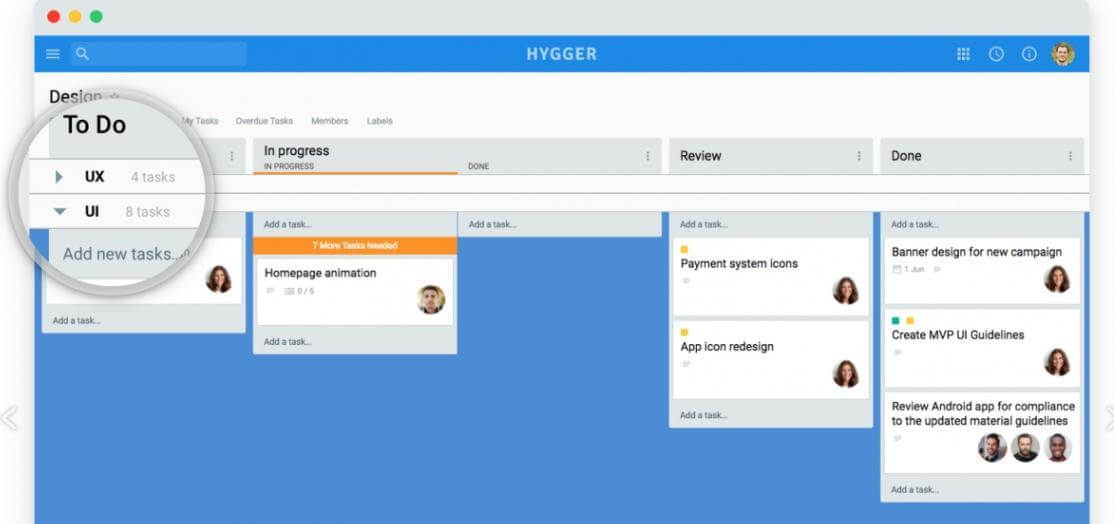
4.3. What is a daily Kanban meeting?
Any internal meeting is the basic element of a company’s culture. It doesn’t matter what the agenda of the meeting is: to discuss a new exhibition booth or iterations before the product release. This will provide you with transparency. Any status meeting should result in benefits, even if it lasts 15 minutes.
A daily Kanban is aimed to minimize the time spent on the tasks at all its stages. Kanban meetings are not required. However, they may really influence the processes. Usually, such a meeting is focused on a specific board and identifies the current bottlenecks.
How does it happen?
There is a moderator who assembles all participants (typically, a project manager or a product manager). The team focuses on board (can be online tool) and explores tasks from right to left from the top to the bottom and the options for the soonest transferring to the next stage is discussed. Each member may have a speech.
The far right column means the completion of the work. The tasks that are closest to the completion have a high priority. The faster the task moves to the right column, the less time it will take to work on it. Then the moderator clarifies what prevents a particular member from moving a task to the done column. The tasks that were postponed are “sorted out” by team members. Each of them takes tasks to move them to the next column by the next stand up.
There are typical questions that are discussed during the Kanban stand up ( the same as for Scrum meeting). The difference is that they are focused on tasks:
- What disturbs the progress?
- How does the task progress?
- What can be improved?

5. Kanban – Lean and Agile
User stories are broken into tasks In Agile Kanban. The cards are used to track the tasks on the Kanban board.
Agile Kanban differs from Kanban as it has a concept of iteration. Further, no processes are considered.
5.1. Kanban in Value Stream
Kanban is executed in a value stream by focusing on the delivery of value. In software development, Kanban can be visualized as the features flowing across the value stream. All its characteristics are met in the Kanban approach for software development.
5.2. Feature Kanban board
Feature Kanban board is used to track the Feature Driven Development with Kanban Approach.
Every feature is assigned to a single release. Kanban board columns represent releases, so every column includes all the features assigned to the release represented by it. Every feature is broken into stories and every release is broken into iterations.
5.3. Agile Kanban in sub-stream
Each sub-stream that is implemented as an iteration assumes the Kanban approach. Stories are broken into tasks in the iteration. Tasks Kanban boards are used for tracking the status and progress of the story development tasks. Tasks’ current status is displaying in the cards in separate columns on the board.
5.4. Continuous delivery
Continuous delivery is ensured with features tracked on feature Kanban board. Stories representing features tracked on task Kanban board.
Delivery through a release is accomplished by continuous tracking, communication with a customer, adjusting development plan as required, and focusing on the delivery of value.
Both Agile and Kanban highlight team collaboration. It assists in identifying and resolving bottlenecks as required by Kanban.
5.5. Continuous process improvement
Process improvements to enhance the delivery approach continuously are clearly supported in Kanban.
You may use Kanban cards to visualize the requirement passing through the processes of development, analysis, design, product integration, and testing.
This implementation of Kanban in product maintenance allows the reliability and integrity of the product.
6. Kanban vs Scrum
One of the most essential questions for project teams before starting their job is what to choose: Scrum or Kanban?
Actually, there are many similarities between Kanban and Scrum. Both of them are Agile, both assume pull scheduling, require breaking the work into pieces, limit WIP (Kanban at the task level; Scrum at the sprint level), use transparency across the development, focus on delivering releasable software early, etc.
After all, the release plan is continuously optimized based on empirical data (Velocity in Scrum, Lead Time/Cycle Time in Kanban) in both methods.
The main difference between the two methodologies is in iteration length. In Scrum, it lasts 2 weeks, while in Kanban you may provide a developer with tasks every day.
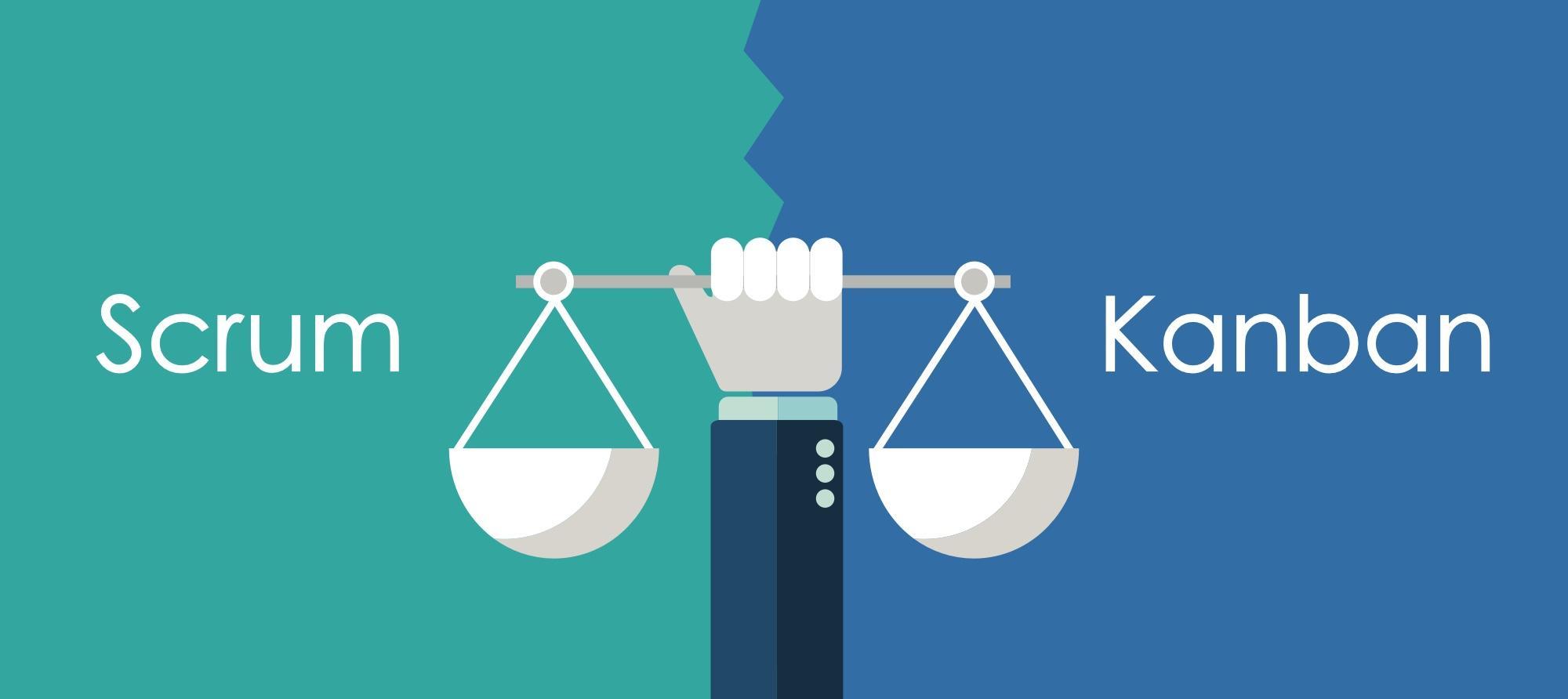
Adapt them together
Kanban and Scrum can be used together by implementing the characteristics that will suit your needs. However, it’s rather important to consider in advance all the constraints of both.
7. Kanban Software
7.1. What is a Kanban tool?
A Kanban tool is a visual project management service that provides project managers and their teams with the full functionality to perform projects according to Kanban principles.
A typical Kanban-based online platform allows you to work with beautiful boards and cards, Swimlanes, color labels, tags, and due dates. Using it, you may analyze and improve your processes to increase business efficiency.
The most essential features of any Kanban tool are:
- Online Kanban-like boards
- To-Do Lists
- Visual project management
- Online documents
- Insightful analytics
- Drag & drop tasks
- Prioritization matrices
7.2. Best Kanban PM Tools
JIRA
The classic is undeniable. This can be also said about JIRA. Different companies of various industries use this platform all over the world. However, to be honest, it’s perfectly suited only for technical teams because of the complexity of the tool.
JIRA is used to plan, track, and release software. This Kanban-based project management and issue tracking software helps to achieve teams’ goals by prioritizing, sorting and keeping track of their tasks. It is often used by large teams and companies, rather than smaller groups or individuals.
JIRA functionality is focused on capturing, assigning, and prioritizing sprints, ideas, and requests. Besides using Kanban, you may use Scrum and Agile planning boards with features that allow integrating data with all the company’s departments. A convenient reporting system and dashboards that give teams a comprehensive view of project progress are also available here.
Essential features:
- Kanban boards
- Sub-tasks
- Time tracking
- Swimlanes and Wip limits
- Gantt charts/timeline
- Reporting
- Integrating abilities
Trello
Trello is no less popular than JIRA. It’s broadly used for projects organized with a Kanban system.
Trello is popular among the teams and individuals that need something like a work pipeline. Freelancers also willingly use it to plan their tasks on a personal board, teams apply it to work collaboratively.
It’s rather easy in using: you create lists for your tasks and customize them with steps in your workflow or as separate parts of a project. To hold everything in one place, it’s possible to add checklists, labels, due dates, mentions, and comments.
Essential features:
- Kanban boards
- Sub-tasks
- Checklists
- Drag and drop functionality
- Activity log
- Deadline reminders
- Search function
Hygger
Hygger is a new generation of project management tools. The platform with a built-in prioritization system helps various teams to stay focused on their tasks and grow.
Except for convenient Kanban boards, Hygger allows utilizing some project boards: a list board (to-do lists), Sprint board and Timeline.
Here you’ll find wide functionality from collecting and prioritizing ideas to development processes based on the popular Kanban and Scrum methods.
Prioritization frameworks are what makes the tool competitive and beneficial for many companies. In Hygger, you’ll find the Eisenhower matrix, Value and Effort prioritization matrix, Value vs Risk matrix, ICE prioritization model, RICE scoring system, and the advanced Weighted scoring that allows evaluating features by your own criteria.
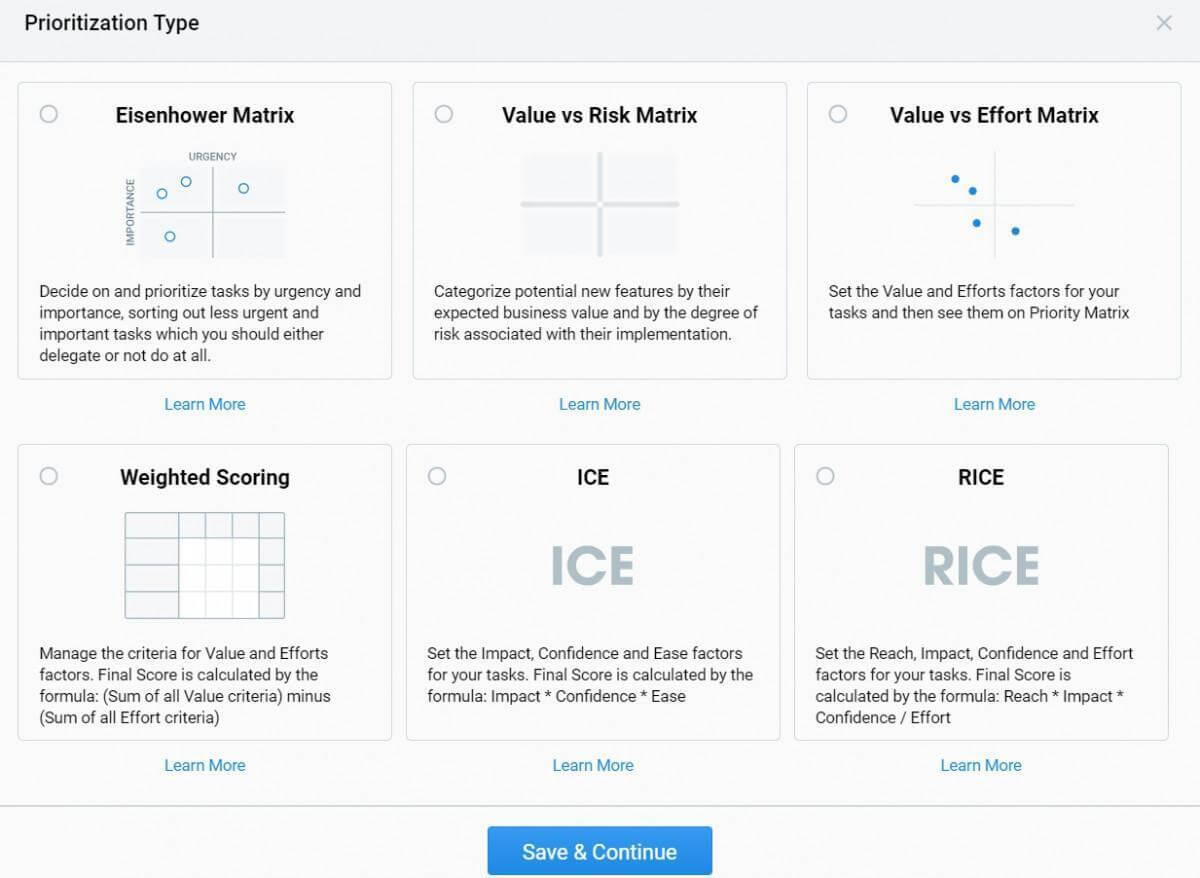
Essential features:
- Kanban boards
- Sub-tasks
- To-do lists
- Swimlanes and WIP limits
- Time tracking
- Timelines
- Checklists
- Feature prioritization
Different teams from all over the world apply and customize these project management platforms to fit their unique needs and work styles in accordance with the Kanban concept. From sales and marketing to HR and, of course, development.
8. Get started with Kanban
Yes, today Kanban looks natural beyond software & IT sphere. You may apply it everywhere.
Thanks to its roots in manufacturing, Kanban is a fit in a non-technical environment as well, with great benefits to companies and teams wanting to become Lean and Agile and deliver high-quality products and services.
Kanban is widely applied in traditional project management. Nowadays a variety of global companies, advertising agencies, recruitment organizations, insurance offices, and many others believe in Kanban and want to streamline their processes, eliminating waste and improving quality.
What do you think about Kanban? Have you faced its pros and cons personally? Please, share your experience with us!
Learn more with Hygger 
This quick Kanban tutorial probably gives you just a common introduction about Kanban. In order to understand more and master Kanban, you’ll definitely need more publications. Here a short list of our articles, that can be helpful:
- How to do Kanban with Hygger Software?
- What’s the Difference Between Scrum and Kanban?
- All About Daily Kanban Stand Up
and, the best books about Kanban worth to read:
- Agile Project Management with Kanban by Eric Brechner
- Stop Starting, Start Finishing! by Arne Roock
- Kanban from the Inside by Mike Burrows
- Personal Kanban: Mapping Work | Navigating Life by Jim Benson and Tonianne DeMaria Barry
- Running Lean: Iterate from plan A to a plan that works by Ash Maurya




